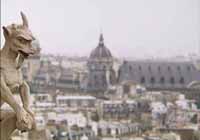 |
 |
 |
| Mary Alice White, a researcher at Columbia Teacher's College has found that young people learn more than half of what they know from visual information, but few schools have an explicit curriculum to show students how to think critically about visual data.
In a society where powerful interests employ visual data to persuade (what Alvin Toffler calls "info-tactics") schools must show students how to look beyond the surface to understand deeper levels of meaning and the tactics employed to sway their thinking. There is a danger that these images will serve as decoration rather than information unless we show them how to interpret (make meaning of) the data. Many libraries and other groups are busily digitizing collections so that you and your students can explore great pictures and documents from your nation's past or from the archives of other nations. The National Library in New Zealand is a world leader in digitizing and sharing its collection at "The Library without Walls."
2. Once you have enlarged the portrait, copy and paste it into MS Word, using your right-click to copy and then paste. 3. Next you will collect and paste alongside the Hodges portrait one by John Webber in 1782 - a portrait recently acquired by Australia. Click http://www.hinchhouse.org.uk/fourth/cook1.jpeg Note comment from site: "Webber painted Cook three times from life, twice in 1776 and once in 1777. The first two paintings are in the National Portrait Gallery, London, and the National Art Gallery, Wellington. The third, painted in Tahiti, was given by Cook to his friend Chief Tu (Otoo) and has since disappeared." 4. Now for your third and final portrait. Click http://www.nmm.ac.uk/mag/pages/mnuExplore/ViewLargeImage.cfm?ID=BHC4227&letter=c This link will take you to another view of Cook painted by William Hodges, who sailed with Cook. Copy and paste this image alongside the first two so you have a trio. 5. Work with your partner to see if you can extract from these three portraits some essential truths about Cook as suggested by Rebecca West below. Make three lists of inferences about Cook's personality and character under each portrait. To what extent do your lists echo each other? QUOTATION: 6. Having many great pictures is not especially valuable unless students can interpret the information. In your learning log, write your thoughts about the following:
7. The secret to developing challenging activities with such visual resources is to emphasize juxtaposition. When they must compare and contrast several photographs, paintings, ideas or industries, it creates cognitive dissonance and requires fresh thinking. Read this article on how these strategies can work well in your classroom. (click here) "Students in Resonance: Provoking Fresh Thought and Deep Reasoning with Dissonance, Contrast and Juxtaposition." Note on copyright "Students are most welcome to download and print images from Timeframes for inclusion in their class reports and for their research. David Adams, Team Leader Copying Services
Other visual literacy resources: Julia Morton's Photography
The Thinker The Web Museum The Library of Congress Te Waimano - Waters of the Millennium - a web site of Alexander Turnbull Library images to mark the beginning of the new millennium Back up Activity The Library of Congress is busily digitizing its collections so that you and your students can explore great pictures and documents from the American past. One collection of photographs from the turn of the century, the Detroit Publishing Collection, supports powerful inquiry with a search engine.
2. Once you find the picture, enlarge it by clicking on the thumbnail and then point your cursor into the middle of the photograph. Hold your mouse button down until a menu appears which includes the option "Copy this Image." Select that image and then paste the photograph into a word processing file you have opened with Word or AppleWorks. 3. Now join with your partner to probe beyond the obvious and infer psychological content. Who is the leader of this group? Write down your choice and then make a list of at least 8 reasons why you selected that one person over the others. Make your reasons as specific as possible, supplying the visual data, details and evidence to build your case.
|